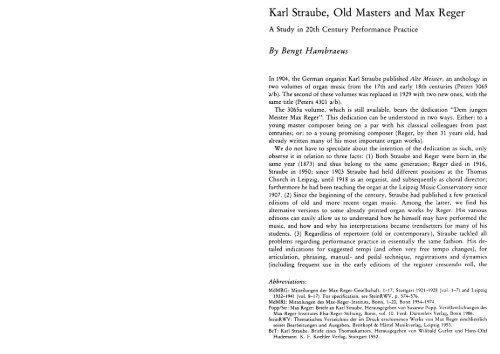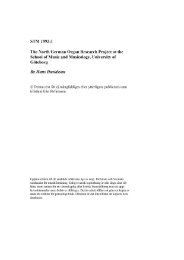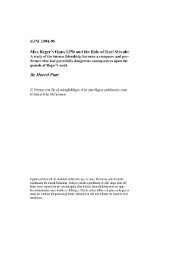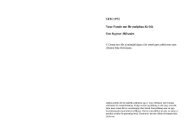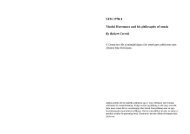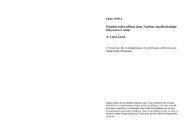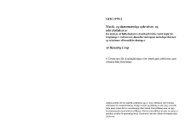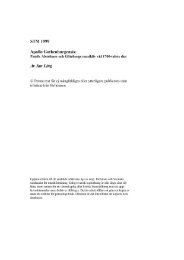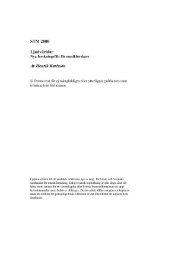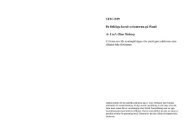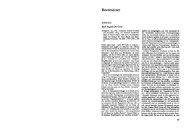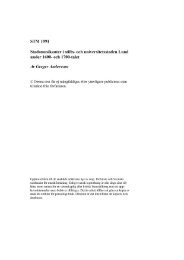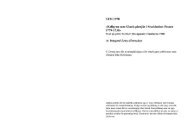You also want an ePaper? Increase the reach of your titles
YUMPU automatically turns print PDFs into web optimized ePapers that Google loves.
Karl Straube, Old Masters and Max Reger<br />
A Study in 20th Century Performance Practice<br />
<strong>By</strong> <strong>Bengt</strong> <strong>Hambraeus</strong><br />
In 1904, the German organist Karl Straube published Alte Meister, an anthology in<br />
two volumes of organ music from the 17th and early 18th centuries (Peters 3065<br />
a/b). The second of these volumes was replaced in 1929 with two new ones, with the<br />
same title (Peters 4301 a/b).<br />
The 3065a volume, which is still available, bears the dedication “Dem jungen<br />
Meister Max Reger”, This dedication can be understood in two ways. Either: to a<br />
young master composer being on a par with his classical colleagues from past<br />
centuries; or: to a young promising composer (Reger, by then 31 years old, had<br />
already written many of his most important organ works).<br />
We do not have to speculate about the intention of the dedication as such, only<br />
observe it in relation to three facts: (i) Both Straube and Reger were born in the<br />
same year (1873) and thus belong to the same generation; Reger died in 1916,<br />
Straube in 1950; since 1903 Straube had held different positions at the Thomas<br />
Church in Leipzig, until 1918 as an organist, and subsequently as choral director;<br />
furthermore he had been teaching the organ at the Leipzig Music Conservatory since<br />
1907. (2) Since the beginning of the century, Straube had published a few practical<br />
editions of old and more recent organ music. Among the latter, we find his<br />
alternative versions to some already printed organ works by Reger. His various<br />
editions can easily allow us to understand how he himself may have performed the<br />
music, and how and why his interpretations became trendsetters for many of his<br />
students. (3) Regardless of repertoire (old or contemporary), Straube tackled all<br />
problems regarding performance practice in essentially the same fashion. His de-<br />
tailed indications for suggested tempi (and often very free tempo changes), for<br />
articulation, phrasing, manual- and pedal technique, registrations and dynamics<br />
(including frequent use in the early editions of the register crescendo roll, the<br />
Abbreviations:<br />
MdMRG: Mitteilungen der Max-Reger-Gesellschaft, 1-17, Stuttgart 1921-1928 (vol. 1-7) and Leipzig<br />
1932-1941 (vol. 8-17). For specification, see SteinRWV, p. 574-576.<br />
MdMRI: Mitteilungen des Max-Reger-Instituts, Bonn, 1-20, Bonn 1954-1974.<br />
Popp/Str: Max Reger: Briefe an Karl Straube. Herausgegeben von Susanne Popp. Veröffentlichungen des<br />
Max-Reger-Institutes Elsa-Reger-Stiftung, Bonn, vol. i O. Ferd. Dümmlers Verlag, Bonn i 986.<br />
SteinRWV: Thematisches Verzeichnis der im Druck erschienenen Werke von Max Reger einchliesslich<br />
seiner Bearbeitungen und Ausgaben, Breitkopf & Härtel Musikverlag, Leipzig 1953.<br />
BeT: Karl Straube. Briefe eines Thornaskantors. Herausgegeben von Wilibald Gurlitt und Hans-Olaf<br />
Hudemann. K. F. Koehler Verlag, Stuttgart 1952.


